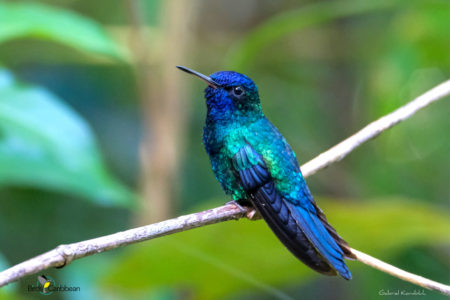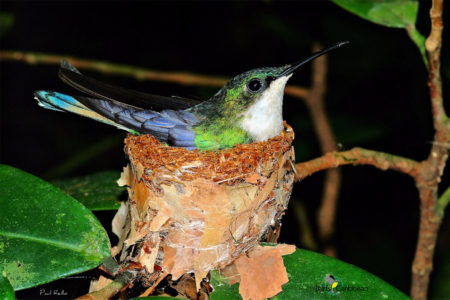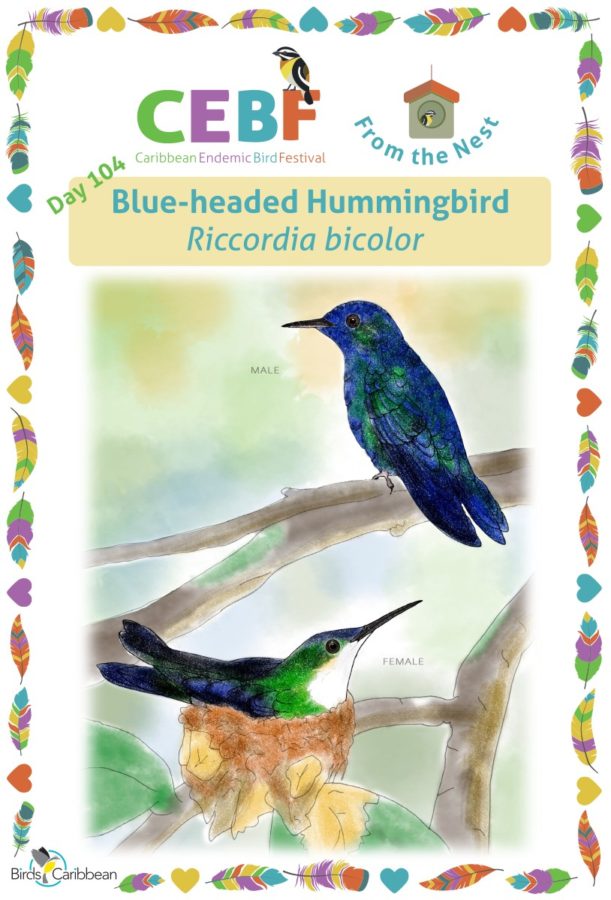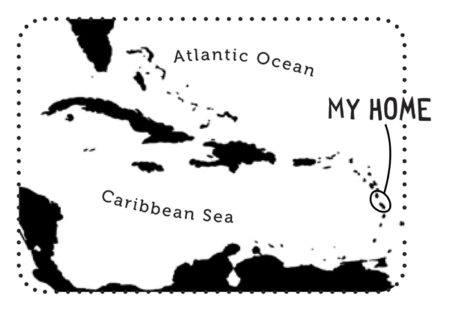Celebrate the Caribbean Endemic Bird Festival (CEBF) with us! Our theme in 2022 is “Loving Birds is Human Nature”. Have fun learning about a new endemic bird every day. We have colouring pages, puzzles, activities, and more. Download for free and enjoy nature with your family at home.
Endemic Bird of the Day: Blue-headed Hummingbird
Arguably the most beautiful hummer in the Lesser Antilles region, the Blue-headed Hummingbird is not to be missed! If you find yourself in high elevations of rainforest to elfin woodlands on Dominica and Martinique, be sure to look out for this naturally bold bird. During the breeding season, you may be treated to a special sight as females will sit on their nests just inches away from people! This medium-sized hummer is ~9-11cm. Males are deep blue all over with some metallic green on their back and underparts, and a sparkling “gem blue” color on the head. Females are slightly shorter in length and resemble a bigger version of the Antillean Crested Hummingbird, with pale underparts, green head, more green on the back, and longer beak. She carries a white tip on her tail, which looks like a little lady wearing a skirt.
Polygynous in nature, the male will mate with several females but guards specific small groups of flowers for different females. He keeps busy trying to prevent other birds from coming to these flowers, though he is often unsuccessful. The male prefers a variety of flowers, which include Palicourea crocea, Psychotria urbaniana, and Rudgea citrifolia—all belonging to the coffee family (Rubiaceae). Males and females feed on the same flowers, but females are often seen at the fringe edges of forests, adjacent to citrus and coffee plantations, feeding.
From February to June, the female engages in nesting with no assistance from the male. On her own, she constructs an intricate cup nest with very fine plant fibers, which include fluff from silk cotton trees and the furry part of tree ferns. Spider webs are used on the inner part of the cup, which becomes elastic as the chicks grow. The outer part of the nest is walled with lichens, which creates a camouflage effect. This is useful given that she nests in very small trees that are at eye-level for most humans. Clutch size is two small off-white eggs.
The voice of the male Blue-headed Hummingbird is a strong click-click-click which sounds like snapping of the fingers. The female is somewhat softer and often drags the syllables especially when nesting.
The Blue-Headed Hummingbird is high on the list of birders who visit Dominica for birding. They are not globally threatened but are a restricted-range species occurring on just two islands. Their populations should be monitored carefully as they are highly vulnerable to and recover slowly from severe hurricanes which are increasing in the Caribbean with climate change. Learn more about this species, including its range, photos, and calls here.
Colour in the Blue-headed Hummingbird
Download our West Indies Endemic Bird colouring page. Use the photos below as your guide, or you can look up pictures of the bird online or in a bird field guide if you have one. Share your coloured-in page with us by posting it online and tagging us @BirdsCaribbean #CEBFfromthenest
Listen to the calls of the Blue-headed Hummingbird
The calls of the Blue-headed Hummingbird include a metallic-sounding trill.
Puzzle of the Day
Click on the image below to do the puzzle. You can make the puzzle as easy or as hard as you like – for example, 6, 8, or 12 pieces for young children, all the way up to 1,024 pieces for those that are up for a challenge!


Activity of the Day
FOR KIDS AND ADULTS: How much can you remember about the birds we have featured during the Caribbean Endemic Bird Festival 2022? Test your memory of your newly gained knowledge of these wonderful birds with our 2022 Caribbean Endemic Bird Quiz! Today we have Part One of a two-part bird trivia quiz. Try to answer all the questions without checking back to our posts or looking up the answers online or in your bird guides! But just in case you do get stuck you or if you want to do some studying before you try the quiz you can read about all our featured endemic birds here or take a browse on ebird. Once you’ve finished the quiz you can click on the “View Score” link to see how many you got right and find out the correct answers! Note: the page might look blank when you finish, but if you scroll back up you should be able to find the link to “View Score”.
Now that you’ve completed our quiz – enjoy this short video of a Blue-headed Hummingbird in the wild!



2 comments
Comments are closed.